Morocco is a country with endless surprise, where history, culture and natural beauty go together to create unforgettable experience. While iconic destinations such as Markedch, Fes and the Sahara desert often steal the spotlight, the country is also at home for a treasure of hidden pearls, waiting to find. From lonely beaches and dramatic mountain villages to ancient Kasbah and juicy Oz, little known places in Morocco offer a unique perspective on their rich heritage and different scenarios.
Whether you are looking for hidden valleys like Bougmez – known as “Happy Valley” – al -hosema near Al -hosema, exposing a coastal tax like Kaila Iris, lifts unforgettable moments for all types of secret destinations in Morocco. Each website tells its story, from the old ruins of Volubilis near Maole Idris to the mysterious landscape of Tagia’s rocks.
For travelers seeking authenticity and adventures, these secret places provide an opportunity to escape the audience and contact the pristine beauty in Morocco. Imagine wandering through the pam -pams of the Scaura Ooas, perform miracles in the architectural greatness of the Tinmail Mosque located in the Atlas mountain, or searching the cool water in the lake El Oden surrounded by royal peaks. These places show not only the natural miracles of Morocco, but also its lively local traditions and welcoming communities.
This guide will take you away from the beaten track to discover the best rich mysteries in Morocco-as gives me some form of peace, adventure and cultural prosperity. Whether you are a nature lover, history enthusiastically or just looking for unique experiences, these hidden gems will really make your Moroccan journey really extraordinary.
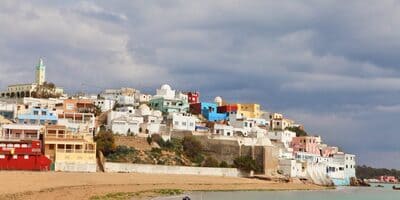
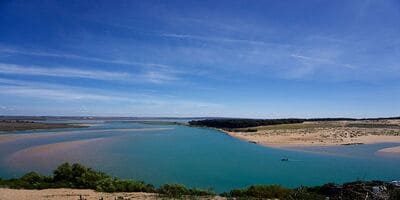
Moulay Bousselham Lagoon
Morocco never surprises. Even after years of discovering their diverse landscapes and lively culture, they always wait in new, unsettled places. Some of these hidden gems reveal themselves unexpectedly, away from general tourism roads.
In this special guide, you will highlight 10 lesser-known places in Morocco. Although some are not completely secret, they stay away from the radar for most travelers. Others are those rarely visited, but they provide a unique and unforgettable experience. Some of these places are still on my list, and I can’t wait to see them soon!
Moulay Bousselham: A Heaven for Birdwatching and Seafood
Located in the Kénitra Province, Moulay Bousselham is an attractive coastal village known for its Merja Zerga Lagoon, a remarkable wetland area. It attracts birdwatching enthusiasts and travelers in search of a peaceful retreat in Morocco.
The lagoon is home to over 100 bird species, including flamingos, grey herons, storks, black-winged stilts, African marsh harriers, marbled teals, and red-knobbed coots. For an unforgettable birdwatching tour, go to the harbor and ask a local guide for a boat trip.
Beyond its natural appeal, Moulay Bousselham is an ideal stop for travelers on the route between Tangier and Marrakech. Leave the restaurant scene and visit the local fish market, where you can buy fresh seafood and have it grilled on-site for a delicious, authentic meal by the sea.
Sidi M'Barek Waterfalls: A Hidden Gem Near Essaouira
On the road to Sidi Kaouki, just 15 minutes south of Essaouira, is one of the best-kept secrets in the region: Sidi M'Barek Waterfalls and their marabouts, a sacred place of spiritual significance.
This breathtaking spot requires a 30-minute hike, with a unique path where locals recommend asking for directions. When you arrive, you’ll be greeted by striking landscapes, reminiscent of oasis scenery, and refreshing waterfalls cascading towards the Atlantic Ocean.
This area is an ideal spot for a picnic or barbecue, offering fantastic views and a tranquil atmosphere. For those seeking wild, untouched nature in Morocco, this hidden gem is a must-visit.

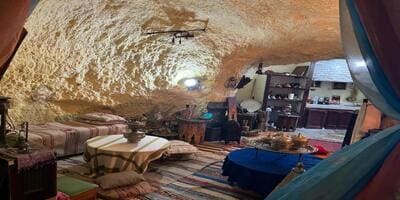
Discover the Unique Cave Dwellings of Bhalil, Morocco
Located at the foot of the Middle Atlas Mountains, just 30 km south of Fez, lies the picturesque village of Bhalil. This hidden gem is known for its troglodyte cave homes, a fascinating feature that sets it apart from other destinations in Morocco. These cave dwellings, carved into the earth, have housed local families for generations and continue to attract curious travelers from around the world.
History of Bhalil’s Cave Houses
These cave homes date back to the 4th century. Originally, they were occupied by indigenous Berber communities and later adapted by other settlers. Over time, they evolved into practical living spaces, blending tradition with modernity. While modernization has led many residents to relocate to contemporary homes, some families still inhabit these historic caves. Several have also been transformed into tourist attractions, offering visitors a rare glimpse into Morocco’s ancient lifestyle.
- 600 cave dwellings dot the village, with approximately 100 still in use as homes or storage spaces. Some are open to tourists, providing a unique opportunity to step inside and experience their cool interiors.
- Stroll Through the Colorful Streets: The vibrant houses and narrow alleyways of Bhalil create a picturesque setting, perfect for photography enthusiasts.
- Discover Local Handicrafts: Women in Bhalil are known for crafting traditional buttons for Moroccan djellabas, a skill passed down through generations.
- Enjoy the Natural Beauty: Surrounded by lush landscapes and seasonal springs, Bhalil offers a serene escape from the hustle and bustle of city life.
Things to Do in Bhalil
- Guided Tours: Hire a local guide to explore the cave homes and learn about their rich history.
- Cultural Experiences: Visit local artisans to see traditional button-making or witness bread baking in a traditional clay oven.
- Unique Overnight Stays: Some cave houses have been transformed into guesthouses with modern amenities, offering visitors an authentic stay in Morocco.
Tips for Visiting Bhalil
- Transportation: Bhalil is easily accessible from Fez by car or taxi.
- Best Time to Visit: Spring and autumn offer the most pleasant weather for exploring the village.
- Respect Local Customs: Always ask for permission before taking photos of people or private homes.
Why Visit Bhalil?
Bhalil is more than just a village—it is a living museum that showcases Morocco’s rich cultural heritage and architectural simplicity. From historic cave homes to its vibrant local traditions, this off-the-beaten-path destination promises an unforgettable experience.
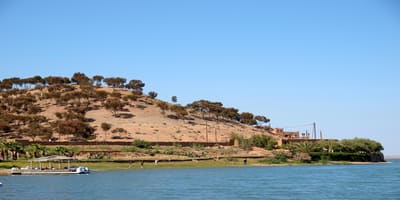
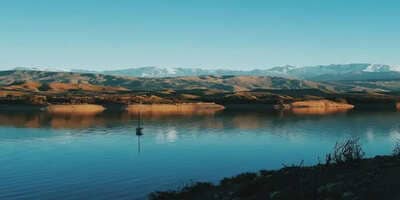
Lalla Takerkoust – A Serene Escape Near Marrakech
Marrakech is surrounded by breathtaking destinations perfect for day trips, and Lalla Takerkoust stands out as a favorite getaway. Located just 40 km from Marrakech, this peaceful retreat offers a refreshing escape from the bustling city, combining natural beauty with exciting activities.
A Man-Made Oasis with Stunning Views
The main attraction of Lalla Takerkoust is its artificial lake, built in 1929 to supply electricity to Marrakech and its surroundings. This 7-km-long reservoir is a picturesque haven, offering tranquil waters and breathtaking views of the Atlas Mountains. Whether you’re looking to relax by the shore or dive into adventure sports, Lalla Takerkoust has something for everyone.
Things to Do in Lalla Takerkoust
1. Water Sports
Thrill-seekers can enjoy jet skiing, paddleboarding, kayaking, and pedal boating on the lake’s calm waters.
2. Relaxation & Dining
The area is home to scenic lakefront beaches, restaurants, and boutique hotels, where you can indulge in traditional Moroccan cuisine while soaking in the serene atmosphere.
3. Outdoor Adventures
Explore the surrounding hills through hiking trails, or rent a quad bike or buggy to discover the rugged landscapes.
4. Paragliding
For breathtaking panoramic views of the lake and the Atlas Mountains, try paragliding, an unforgettable experience for adventure lovers.
Essential Travel Tips
- Transportation: Lalla Takerkoust is easily accessible by shared taxis or private cars from Marrakech. A "Grand Taxi" costs around 15 DH per person.
- Best Time to Visit: Spring and autumn are ideal for enjoying pleasant weather and high water levels in the lake.
- Dining Recommendations: Don’t miss dining at Le Flouka, a popular lakeside restaurant known for its seasonal dishes and stunning views of the snow-capped Atlas Mountains.
Why Visit Lalla Takerkoust?
Lalla Takerkoust offers the perfect blend of relaxation and adventure, making it an ideal destination for families, couples, and solo travelers. Whether you’re swimming in the refreshing waters, savoring Moroccan cuisine at a lakefront restaurant, or exploring nearby Berber villages, this hidden gem promises an unforgettable experience.
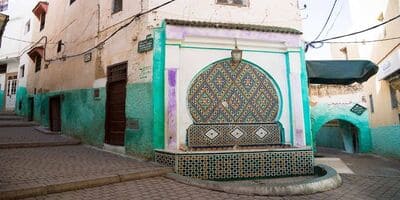
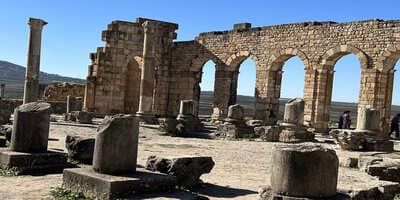
Discover the Sacred Charm of Moulay Idriss, Morocco
Nestled on the slopes of the Zerhoun Mountains in northern Morocco, Moulay Idriss is a city steeped in history and spirituality. Located just 5 km from the ancient Roman ruins of Volubilis, this picturesque town is considered one of Morocco’s holiest cities. Home to descendants of Prophet Muhammad and the founder of Morocco’s first Islamic dynasty, it offers a unique blend of cultural heritage, stunning landscapes, and Moroccan traditions.
A Sacred City with a Rich History
Founded in 789 AD, Moulay Idriss has long been a pilgrimage site and a symbol of spiritual devotion in Morocco. Until 2005, non-Muslims were not allowed to stay overnight, but today, visitors from all backgrounds are welcome to explore its maze-like streets, whitewashed houses, and bustling markets.
While Moulay Idriss’ mausoleum is only accessible to Muslims, the town remains a spiritual heartland for all visitors. For those unable to enter the shrine, the terrace of Sidi Abdellah el Hajjam offers a spectacular view of the green-tiled sanctuary and the surrounding landscapes.
Things to Do in Moulay Idriss
1. Explore the City’s Architecture
Wander through narrow alleyways lined with pastel-colored houses and admire traditional Moroccan craftsmanship.
2. Visit Volubilis
Combine your trip with a visit to Volubilis, a UNESCO World Heritage Site, famous for its well-preserved Roman ruins.
3. Ride a Donkey
Experience local life by riding a donkey around Volubilis or navigating the steep streets of the town.
4. Go Hiking
Discover scenic trails around the Zerhoun Mountains, offering panoramic views of lush valleys and ancient olive groves.
5. Explore the Local Market
Immerse yourself in Moroccan culture by shopping for fresh produce, handmade crafts, and traditional pottery in the bustling souks.
Travel Tips for Moulay Idriss
- Transportation: Moulay Idriss is easily accessible by taxi or bus from Meknes (a 30-minute journey).
- Best Time to Visit: Spring and autumn offer pleasant weather for exploring the town and nearby attractions.
- Cultural Etiquette: Dress modestly, respect local customs, and always ask for permission before photographing people or private homes.
Why Visit Moulay Idriss?
Moulay Idriss is more than just a historic city; it’s a living testament to Morocco’s rich cultural and religious heritage. From sacred sites to breathtaking rural landscapes, this destination promises an authentic and unforgettable experience for travelers seeking spiritual depth and cultural immersion.
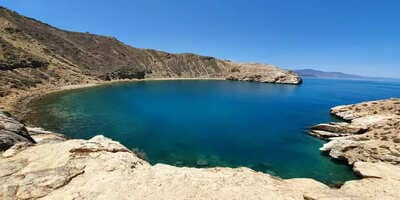

Discover the Hidden Paradise of Plage de Maresdar in Jebha
Tucked away in northern Morocco, Plage de Maresdar is a true hidden gem. Located near the secluded port town of Jebha, this beach offers a unique escape for travelers seeking tranquility and natural beauty. Situated midway between Tetouan and Al Hoceima, it remains largely undiscovered by tourists and locals, making it an ideal destination for those craving an off-the-beaten-path adventure.
A Unique Beach Unlike Any Other
Plage de Maresdar boasts a dramatic landscape, reminiscent of the tropical beaches of Indonesia or Thailand. This untouched paradise is accessible only by a short boat ride from Jebha, adding to its mystique and exclusivity.
For around 100 DH, you can take a local boat trip to reach the pristine shoreline. Once you arrive, you’ll be greeted by crystal-clear turquoise waters, soft golden sand, and a serene atmosphere, making you feel worlds away from the hustle and bustle of city life. Whether you’re looking to relax under the sun or explore the rugged coastline, Plage de Maresdar promises an unforgettable experience.
Things to Do at Plage de Maresdar
1. Swimming & Sunbathing
Take a refreshing dip in the crystal-clear waters or simply relax on the soft golden sand, soaking up the warm Moroccan sun.
2. Scenic Boat Rides
The boat journey to the beach itself is an adventure, offering breathtaking views of Jebha’s coastline and cliffs.
3. Photography
Capture stunning images of the unique rock formations, secluded coves, and unspoiled natural beauty of this hidden paradise.
4. Exploring Hidden Caves & Coves
For those seeking a bit of adventure, venture beyond the main beach to discover hidden caves and rocky outcrops.
Travel Tips for Visiting Plage de Maresdar
- How to Get There:
- Jebha is accessible by car from Tetouan (2 hours) or Al Hoceima (2.5 hours).
- Once in Jebha, you can hire a local boat to reach Plage de Maresdar.
- Best Time to Visit:
- The summer months (June to September) offer the best weather for swimming and beach activities.
- What to Bring:
- Sunscreen, water, snacks, and comfortable shoes for exploring the rocky terrain.
Why Visit Plage de Maresdar?
Plage de Maresdar is a perfect getaway for travelers seeking seclusion and natural beauty. Its remote location and boat-only access make it one of Morocco’s best-kept secrets—a true hidden treasure waiting to be explored.
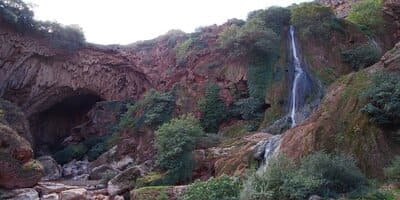
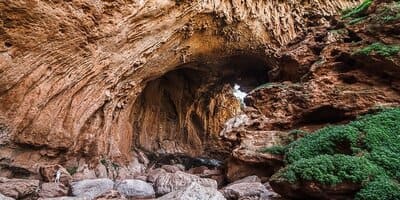
Explore the Breathtaking Iminifri Natural Bridge in Morocco
Located near Demnate, just 70 km from Marrakech and close to the famous Ouzoud Falls, Iminifri Natural Bridge is one of Morocco’s most stunning geological wonders. Carved over millions of years by the Tisslit River, this natural stone arch is a must-visit for nature lovers, adventure seekers, and photography enthusiasts.
A Natural Marvel with a Rich History
The name “Iminifri“ originates from the Amazigh (Berber) language, meaning “Mouth of the Cave“, a perfect description of this incredible rock formation.
Recognized as a Site of Biological and Ecological Interest (SIBE), Iminifri spans over 300 meters and rises 20 meters above the river, offering breathtaking views and a unique connection to Morocco’s natural heritage.
Why Visit Iminifri Natural Bridge?
1. Unique Geological Formation
The massive limestone arch, shaped by erosion, showcases stunning rock formations. Locals often compare its silhouette to the map of Africa, a feature pointed out by guides during visits.
2. Rich Biodiversity
Home to over 95 species of birds, including the rare Red-billed Chough (Pyrrhocorax pyrrhocorax), Iminifri is a paradise for bird watchers and wildlife enthusiasts.
3. Breathtaking Scenery
The contrast of red and orange limestone cliffs, lush green vegetation, and the flowing Tisslit River creates a peaceful and picturesque retreat into nature.
4. Cultural & Culinary Delights
After exploring the bridge, enjoy authentic Moroccan cuisine at local restaurants nearby. Don't miss the traditional rabbit tagine, a local specialty!
Top Activities at Iminifri
✅ Hiking:
- A short, manageable trail leads to the bridge, but sturdy footwear is recommended.
- For adventurous hikers, nearby trails offer panoramic views of the stunning landscape.
📸 Photography:
- Capture the majestic limestone arch, vibrant rock textures, and unique geological formations.
🔍 Guided Tours:
- Local guides offer insights into Iminifri’s geological history, pointing out hidden formations and fascinating rock carvings.
Travel Tips for Visiting Iminifri
🚗 How to Get There:
- Easily accessible by car from Marrakech or Azilal.
- Parking is available near the site.
🌿 Best Time to Visit:
- Spring and autumn offer mild temperatures, making it ideal for hiking and exploration.
🎒 What to Bring:
- Comfortable shoes for hiking
- Water & snacks for the trip
- A camera to capture the breathtaking scenery
Why Iminifri Should Be on Your Travel List
Iminifri Natural Bridge is more than just a geological wonder—it’s a remarkable experience that blends Morocco’s natural beauty with its rich cultural heritage. Whether you’re hiking through its scenic trails, admiring the breathtaking rock formations, or savoring delicious local cuisine, this hidden gem promises an unforgettable adventure.

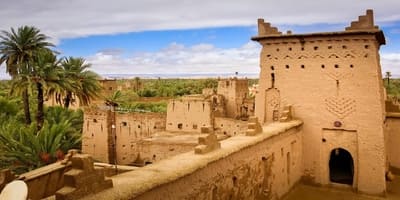
Skoura Oasis – Morocco’s Hidden Gem of Tranquility and History
Nestled in the heart of Morocco, just 40 km from Ouarzazate, Skoura Oasis is a lush haven of palm groves, ancient kasbahs, and authentic Berber culture. Often overlooked by travelers rushing to the Sahara Desert or the famous Ait Benhaddou, Skoura offers a serene retreat and a glimpse into Morocco’s rich history and natural beauty.
Why Visit Skoura Oasis?
1. Endless Palm Groves & Natural Beauty
Known as the “Oasis of 1,000 Palms”, Skoura is a vast expanse of date palms, olive trees, and almond orchards. Walking or cycling through the dense greenery is an immersive experience, with the rustling leaves and lush landscapes creating an atmosphere of tranquility. The oasis is also a haven for migratory birds, making it a delightful destination for nature lovers.
2. Kasbah Amridil – A Historical Treasure
One of the most iconic landmarks in Skoura, Kasbah Amridil, dates back to the 17th century and is one of Morocco’s best-preserved fortresses. This architectural masterpiece provides a fascinating glimpse into traditional Moroccan life and has even been featured in films like Ali Baba and the Forty Thieves and Lawrence of Arabia.
3. Authentic Berber Culture & Local Life
Skoura offers a unique opportunity to connect with local Berber communities. Visitors can:
✅ Explore traditional villages and witness daily life.
✅ Enjoy homemade tagines in local homes.
✅ Stay in charming guesthouses, offering an authentic Moroccan experience.
Top Things to Do in Skoura
🏜️ Explore Kasbahs – Besides Kasbah Amridil, visit Kasbah Aït Abou and other lesser-known fortresses hidden within the oasis.
🚴 Cycling & Walking Tours – Discover Skoura’s palm groves at a slow pace, taking in the breathtaking scenery.
📸 Photography – Capture the contrasting landscapes of lush greenery against the backdrop of the arid desert.
🍽️ Taste Local Cuisine – Savor authentic Moroccan dishes made with fresh, locally sourced ingredients.
Travel Tips for Visiting Skoura
🚗 How to Get There:
- By car: Skoura is 40 km from Ouarzazate (around 45 minutes).
- By bus or taxi: Frequent shared taxis and buses are available from Ouarzazate.
🌿 Best Time to Visit:
- Spring (March–May) – The oasis is at its greenest and most vibrant.
- Autumn (September–November) – Pleasant temperatures make it ideal for exploring on foot or by bike.
🎒 What to Bring:
- Comfortable walking shoes
- A camera for stunning landscapes
- Sunscreen & water for outdoor activities
Why Skoura Oasis Should Be on Your Morocco Itinerary
Unlike the crowded tourist hotspots, Skoura Oasis offers a peaceful escape into nature, history, and culture. Whether you’re exploring its ancient kasbahs, cycling through lush groves, or immersing yourself in Berber traditions, this hidden gem promises an unforgettable experience.
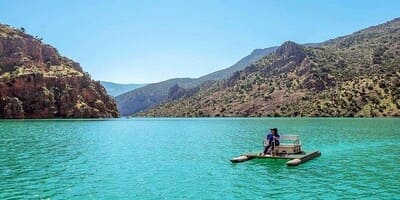
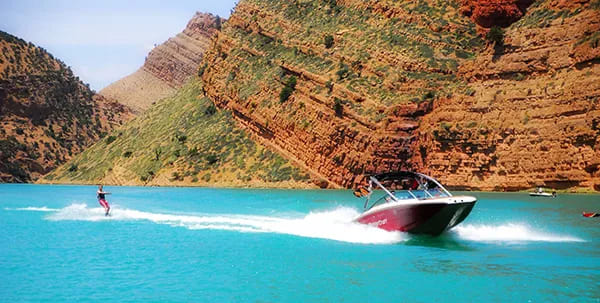
Bin El Ouidane Lake – A Tranquil Escape in Morocco’s Atlas Mountains
Tucked away in the heart of the High Atlas Mountains, Bin El Ouidane Lake is one of Morocco’s most breathtaking and serene destinations. Just an hour’s drive from the famous Ouzoud Waterfalls in Azilal Province, this artificial lake, created by the Bin El Ouidane Dam in 1953, is a hidden gem offering a perfect mix of relaxation, adventure, and stunning scenery.
Why Visit Bin El Ouidane Lake?
1. Breathtaking Scenery
Surrounded by rugged mountains and lush greenery, the lake’s crystal-clear blue waters create a picturesque and tranquil atmosphere. It’s a haven for photographers, nature lovers, and travelers seeking a peaceful retreat away from city life.
2. Outdoor Adventures
For adventure seekers, Bin El Ouidane is the perfect destination, offering a variety of activities:
🚤 Boating & Kayaking – Rent a local boat or kayak to explore the calm waters of the lake.
🎣 Fishing – The lake is renowned for carp fishing, attracting anglers from around the world.
🥾 Hiking – Nearby scenic trails provide panoramic views of the lake and surrounding landscapes.
🏊 Swimming & Sunbathing – Take a refreshing dip in the cool waters or relax by the shoreline.
3. The Bin El Ouidane Dam – An Engineering Marvel
Standing 133 meters tall and spanning 290 meters, the Bin El Ouidane Dam is an impressive feat of engineering. It plays a crucial role in:
⚡ Generating hydroelectric power for Morocco.
🌾 Irrigating vast farmlands, supporting agriculture in the region.
Visitors can marvel at its size and learn about its impact on Morocco’s economy and environment.
4. Peaceful & Scenic Accommodation
Bin El Ouidane offers a range of lodging options, from boutique hotels to lakeside villas with stunning panoramic views. These serene retreats provide the perfect place to relax and unwind after a day of exploration.
Tips for Visiting Bin El Ouidane
🚗 How to Get There:
- By car: Accessible from Beni Mellal (1 hour), Azilal (30 minutes), or Marrakech (3 hours).
- Scenic mountain roads make the journey as enjoyable as the destination.
🌿 Best Time to Visit:
- Spring (March–May) and Autumn (September–November) – Ideal weather for outdoor activities.
🎒 What to Bring:
- Comfortable hiking shoes
- Sunscreen & water for outdoor activities
- A camera to capture the stunning landscapes
Nearby Attractions
🌊 Ouzoud Waterfalls – One of Morocco’s most famous waterfalls, just an hour away.
🏔️ Aït Bougmez Valley – Also known as the "Happy Valley," this lush region is perfect for hiking and exploring Berber villages.
⛰️ Ahansal Gorge – A dramatic canyon ideal for rock climbing and discovering Morocco’s rugged landscapes.
Why Bin El Ouidane Should Be on Your Travel List
Bin El Ouidane Lake is more than just a scenic spot—it’s an experience that blends nature, adventure, and cultural discovery. Whether you’re boating on its tranquil waters, hiking its picturesque trails, or simply soaking in the peaceful atmosphere, this destination promises unforgettable memories.
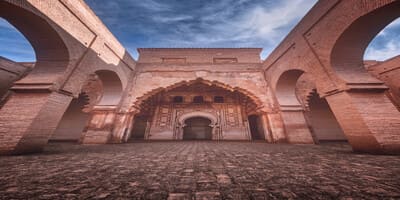
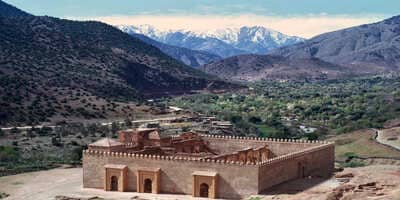
Tinmel Mosque – A Historic Gem in Morocco’s High Atlas Mountains
Hidden deep in the High Atlas Mountains, Tinmel Mosque stands as a testament to Morocco’s rich architectural and historical heritage. Built in the 12th century by the Almohads, this stunning structure is not just a religious site, but also a symbol of power and culture. Located along the Tizi n’Test Pass, it offers visitors a glimpse into Morocco’s past, surrounded by breathtaking mountain landscapes.
Architectural Features of Tinmel Mosque
1. Almohad Architectural Style
The Tinmel Mosque exemplifies Almohad architecture, characterized by:
- Massive exterior walls, giving the structure a fortress-like appearance.
- Minimalist decoration, focusing on grandeur and simplicity.
2. T-Plan Layout
- The mosque follows a "T-type" layout, with nine longitudinal aisles intersected by a central transverse nave, leading to the Mihrab (prayer niche).
3. Unique Tower Placement
- Unlike most Moroccan mosques, Tinmel’s minaret is positioned behind the Mihrab, creating an unusual yet striking architectural element.
4. Intricate Geometric Ornamentation
- Muqarnas (stalactite-like decorative elements) and geometric patterns around the Mihrab draw visitors’ eyes to this sacred focal point.
- The arches and columns reflect classic Almohad craftsmanship, similar to the Kutubiyya Mosque in Marrakech.
How to Visit Tinmel Mosque
🚗 Getting There:
- The mosque is located along the Tizi n’Test Pass, a scenic mountain route.
- Best accessed by car from Marrakech (about 2.5 hours away).
🕌 Guided Tours:
- English-speaking guides are available to provide historical and architectural insights.
- Hiring a guide supports local communities while enhancing your visit.
🌿 Best Time to Visit:
- Spring and autumn offer pleasant weather for exploring both the mosque and the surrounding High Atlas landscapes.
Why Visit Tinmel Mosque?
Beyond its stunning architecture, Tinmel Mosque is a window into Morocco’s powerful Almohad dynasty. Walking through its serene ruins, visitors can immerse themselves in centuries of history, reflecting on the religious and cultural significance of this once-thriving spiritual center.
This hidden treasure is a must-visit for history lovers, architecture enthusiasts, and travelers seeking a deeper connection to Morocco’s past.
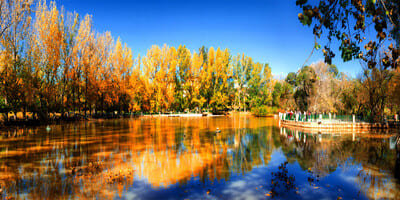

Ifrane: The Swiss Alps of Morocco
Nestled in the Middle Atlas Mountains, Ifrane is often referred to as “Little Switzerland” due to its European-style architecture, pristine streets, and lush green landscapes. This charming town offers a striking contrast to Morocco’s bustling medinas and desert landscapes, making it a perfect retreat for nature lovers and adventure seekers.
A Unique Blend of Cultures and Architecture
Ifrane was established in the 1930s during the French Protectorate as a mountain resort, designed to provide colonial families an escape from Morocco’s scorching summers.
- European Influence: The city’s Swiss chalet-style houses with sloped roofs, wooden balconies, and beautifully manicured gardens reflect a strong Alpine influence.
- Lush Greenery: Tree-lined streets feature imported species like lilacs and chestnuts, enhancing the town’s tranquil ambiance.
- One of Morocco’s Cleanest Cities: Known for its immaculate streets and peaceful atmosphere, Ifrane is a favored destination for both locals and international travelers.
Whether blanketed in snow during winter or blooming with greenery in summer, Ifrane offers year-round charm.
Top Things to Do in Ifrane
1. Explore the Charming Town Center
🚶 Wander through well-organized streets, admire the red-tiled chalets, and relax in beautifully landscaped parks.
2. Visit Al Akhawayn University
🏛️ This prestigious institution, modeled after American universities, adds an intellectual atmosphere to the city. Its stunning architecture makes it a must-visit.
3. Enjoy Outdoor Activities
- ❄️ Winter (Dec–Feb): Ski or snowboard at Michlifen Ski Resort, a popular winter getaway just 20 minutes from Ifrane.
- 🌿 Summer (Mar–Jun): Hike through the Cedar Forests, enjoy picnics by Lake Aoua, or explore nearby national parks.
4. Discover the Atlas Lion Statue
🦁 One of Ifrane’s most iconic landmarks, this massive stone lion was carved by a German prisoner during World War II and symbolizes strength and resilience.
5. Spot Wildlife in the Cedar Forests
🐒 Explore the surrounding cedar forests, home to Barbary macaques and various migratory birds—a paradise for nature enthusiasts.
Tips for Visiting Ifrane
📅 Best Time to Visit:
- ❄️ Winter (Dec–Feb): Perfect for snow activities.
- 🌿 Spring & Summer (Mar–Jun): Ideal for hiking, wildlife spotting, and exploring the greenery.
🚗 How to Get There:
- Ifrane is easily accessible by car or bus from:
- Fes (1 hour)
- Meknes (1.5 hours)
🏨 Where to Stay:
- Choose from charming boutique hotels or cozy chalets that complement the city’s Alpine vibe.
Why Visit Ifrane?
Ifrane is more than just a scenic mountain town—it’s an experience that blends natural beauty, cultural heritage, and outdoor adventure. Whether you’re strolling through its European-style streets, skiing on snow-covered slopes, or enjoying the crisp summer air, Ifrane offers a refreshing escape from Morocco’s bustling cities and desert heat.


